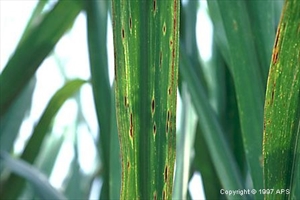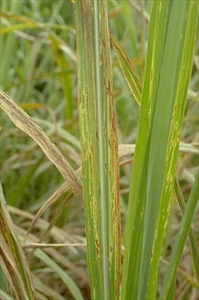Sugarcane eye spot
Pacific Pests, Pathogens and Weeds - Online edition
Pacific Pests, Pathogens & Weeds
Sugarcane eye spot (305)
Bipolaris sacchari. Previous names are Cercospora sacchari, Drechslera sacchari and Helminthosporium sacchari.
Asia, Africa, North, South and Central America, the Caribbean, Europe, Oceania. It is recorded from Australia, Fiji, French Polynesia, Federated States of Micronesia, New Zealand, Palau, Papua New Guinea, Samoa, Solomon Islands, Vanuatu.
Sugarcane, and its relatives, and a few other members of the grass family (Poaceae), e.g., Sudan grass, pearl millet (Pennisetun glaucum), elephant grass (Pennisetum purpureum), barnyard grass (Echinochloa), citronella grass (Cymbopogon citratus).
A fungal disease of sugarcane, causing an eyespot and seedling blight. Spots on the leaves and stalks run parallel to the veins; they are elliptical, 12 × 6 mm, reddish with pale yellow halos. Above the spots are reddish-brown to yellow-brown streaks, extending upwards towards the leaf tips. These are sometimes known as 'runners'. The runners are said to be caused by the toxin produced by the fungus. A blight may develop on young plants as the spots join together, especially under cool conditions.
Spread of the fungus is by spores in wind and rain. The spores are produced in large numbers on the leaves.
Eyespot is a minor disease, and it is very unlikely that it will reduce the yields of the sugarcane varieties presently grown. Whether the same applies to varieties grown in the subsistence economy has not been reported.
Look for the elliptical brown spots with surrounding bright yellow halos, and reddish-brown to yellowish streaks above. Sometimes, the spots merge to form a blight on seedlings.
CULTURAL CONTROL
The only practical method of controlling this disease (if needed) is by using resistant varieties.
RESISTANT VARIETIES
Eyespot is a minor disease as most commercial varieties are resistant, even though they have not been selected or bred for resistance.
CHEMICAL CONTROL
Fungicides are not a practical way of controlling this disease.
AUTHORS Grahame Jackson & Eric McKenzie
Information (and Photo 3) from Philippe Rott, et al. Sugarcane eyespot disease. University of Florida, IFAS Extension (http://edis.ifas.ufl.edu/sc003). and from Diseases of Australian sugarcane: Field guide. BSES Limited. Australia. (https://sugarresearch.com.au/wp-content/uploads/2017/03/Diseases-of-Australian-Sugarcane-Field-Guide.pdf). Photo 1 MS Irey Diseases, pests, and nonnutritent disorders of sugarcane. The American Phytopathological Society. Photo 2 (taken by Eric McKenzie), and used in this fact sheet, appeared previously in McKenzie E (2013) Bipolaris sacchari. PaDIL - (http://www.padil.gov.au).
Produced with support from the Australian Centre for International Agricultural Research under project PC/2010/090: Strengthening integrated crop management research in the Pacific Islands in support of sustainable intensification of high-value crop production, implemented by the University of Queensland and the Secretariat of the Pacific Community.






